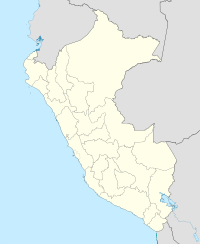Solimana (volcano)
| Solimana | |
|---|---|
 |
|
| Highest point | |
| Elevation | 6,093 m (19,990 ft) |
| Coordinates | 15°24′36″S 72°53′35″W / 15.41000°S 72.89306°WCoordinates: 15°24′36″S 72°53′35″W / 15.41000°S 72.89306°W |
| Geography | |
| Location | Arequipa Region |
| Parent range | Andes |
Solimana is a volcanic massif in the Andes of Peru, South America, that is approximately 6,093 metres (19,990 ft) high. It is considered an extinct volcano that is part of the Central Volcanic Zone, one of the volcanic belts of the Andes. It features a caldera as well as traces of a sector collapse and subsequent erosion. The volcano is glaciated.
It is situated in the Arequipa Region, Condesuyos Province, in the districts of Chichas and Salamanca, and in the La Unión Province, in the districts of Cotahuasi and Toro. Several towns lie around the volcano.
Solimana is part of the Peruvian segment of the Central Volcanic Zone of the Andes. The Central Volcanic Zone in this segment has both generated large composite volcanoes which rise 2–3 kilometres (1.2–1.9 mi) above their basement and monogenetic volcanoes and volcanic fields. This zone of volcanoes includes, from northwest to southeast, Sara Sara, Solimana, Coropuna, Andagua volcanic field, Huambo volcanic field, Ampato, Sabancaya, Cerro Nicholson, Chachani, Misti, Ubinas, Huaynaputina, Ticsani, and Tutupaca, some of which have been active during historical time.
...
Wikipedia

